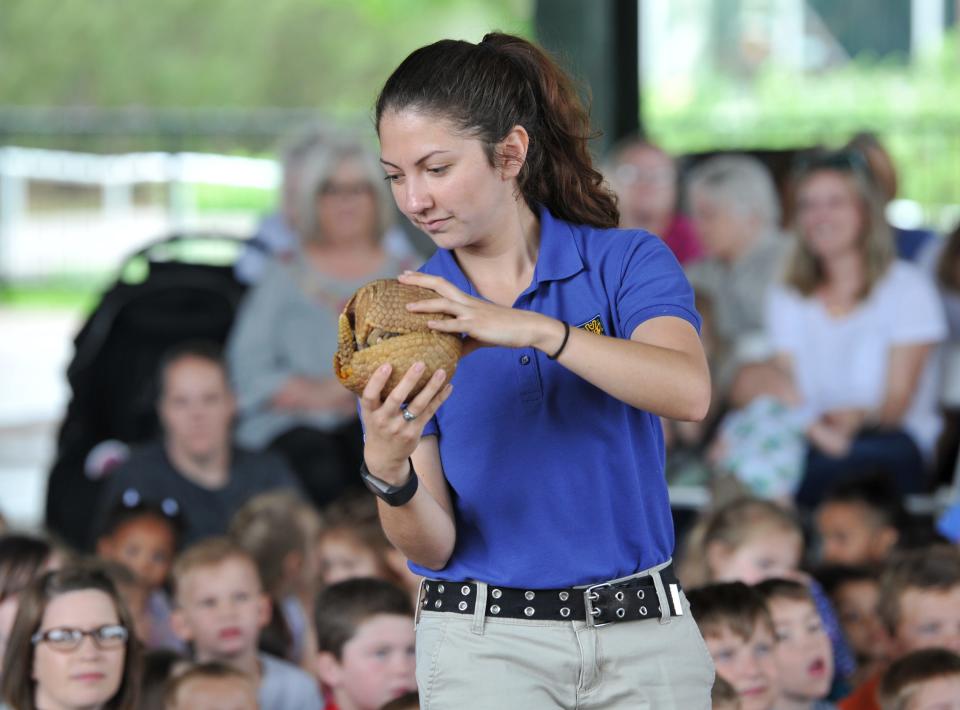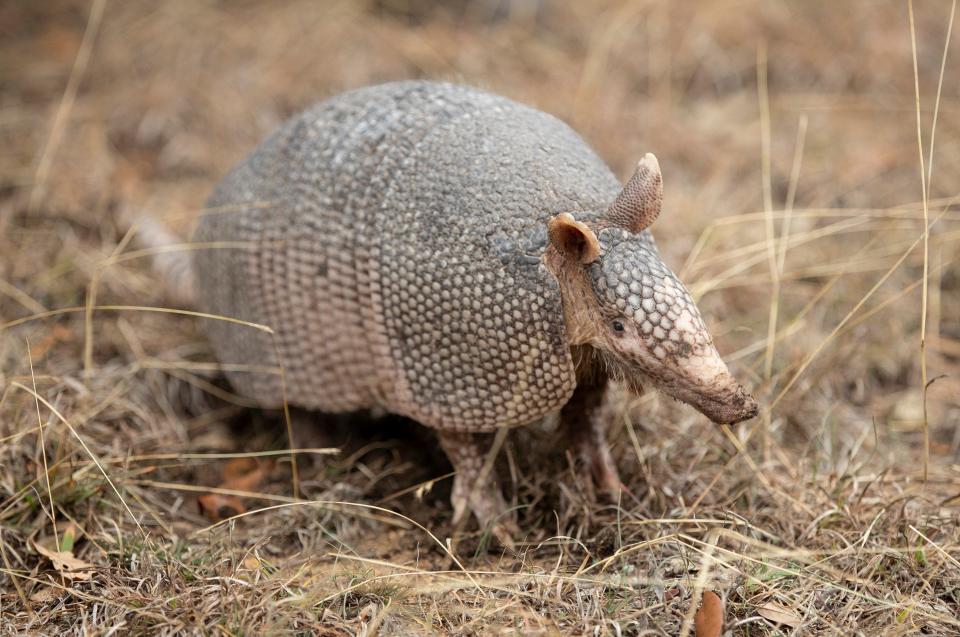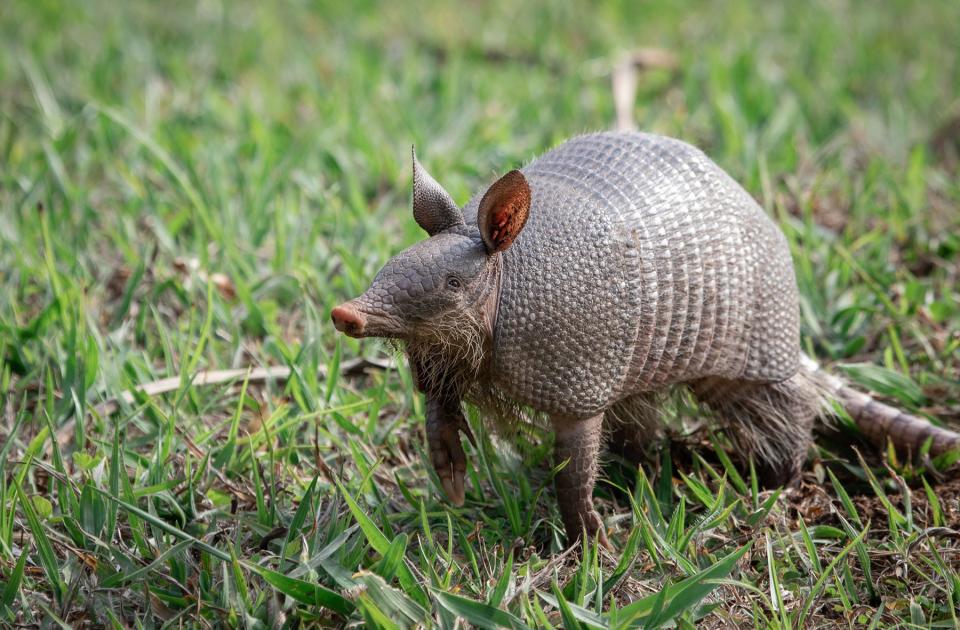Life and lore of the nine-banded armadillo
The Nine-banded Armadillo (Dasypus novemcinctus) was officially adopted as the state small mammal of Texas in 1995. Dasypus translates from Latin and Greek words referring to ‘hairy feet’ and/or ‘hare or rabbit-like’ in appearance and novemcinctus refers to the nine narrow, flexible, bony, bands in the middle of the armadillo’s back and side armor (called its ‘carapace’). Appropriately, the armadillo’s common name means ‘little armored one’! The Nine-banded Armadillo is a unique species which began its migration into Texas and the United States at the end of the Pleistocene ice ages and has expanded its range northward to southern Nebraska and eastward to Florida and parts of Georgia and the Carolinas.

Ice age relatives of the Nine-banded Armadillo were about twice as-large-as the modern species, but were still not large enough to overturn and break into certain types of beverage trucks, as reported in past days to be a foraging activity of the Nine-banded Armadillo by some radio and television advertisements. Armadillos are about the size of a terrier dog (15 – 17 inches body length) with an almost hairless, bone-banded tail of approximately equal length. Its body is well protected by two buckler-like bony plates extending over the shoulders and hips. Nine narrower, more flexible armored bands are found between the shoulders and hips. In addition, parts of its legs, feet, forehead and long, slender snout are covered by dermal bone; leaving only the armadillo’s somewhat leathery ears and more densely furred belly unprotected by bony armor.

Armadillos have small, peg-like teeth in their narrow jaws and a long, sticky tongue used for obtaining food. Armadillos have small eyes and poor eyesight but a good sense of hearing and excellent sense of smell. While using their rigid tails to help with balance, armadillos will sometimes stand on their hind legs and scent the air while foraging. Their legs are short and powerful to facilitate digging and the five toes on each foot end in relatively long, wide claws or unguals. Walking gaits appear rather slow-paced and wobbly; however, armadillos can run for short distances at speeds approaching 30 miles per hour. Their usual escape behavior is to run for dense brush and cover or to seek one (of their usual several) nearby burrows for a retreat. Another alarm or escape behavior probably helps armadillos escape from many of their natural predators but is detrimental when an armadillo encounters an automobile. Armadillos often leap straight upward whenever startled (sometimes as-high-as four feet) and thus might avoid a living predator; however, this behavior often increases the chances that armadillos foraging on roadways may be struck by automobiles.
Armadillos are found throughout North Central Texas and Southwestern Oklahoma; being excluded only from areas with soils which are too dry, hard, or otherwise unsuited for their foraging, burrowing, and denning activities. Habitats include prairies and grasslands, mesquite and oak pasturelands, riparian and streamside areas, suburban areas, and parklands. Armadillos are frequently found near water and are known to take mud baths! Despite their awkward appearance and bony covering, armadillos are capable of swimming if they need to cross rivers and streams and they have the ability to take extra air into their digestive tracts, hold their breath, and walk underwater across the bottoms of streams, staying submerged for up to six minutes.
![The nine-banded armadillo is found in most of Florida. [UF/IFAS]](https://s.yimg.com/ny/api/res/1.2/cHaB4OaQdx9T5ziKfVpD3A--/YXBwaWQ9aGlnaGxhbmRlcjt3PTQyMDtoPTI1Mw--/https://media.zenfs.com/en/times-record-news/5958275c5f33b5665d937fc9d39a9390)
Dens are excavated by digging with the front legs and snout while flinging the soil backward and away with the hind legs. Nesting burrows are usually excavated to a depth of approximately 1.5 meters; whereas, shallower and shorter burrows within an individual armadillo’s home range may serve as temporary resting sites and as traps that attract insects and other invertebrates for the visiting armadillos. Nests are loosely constructed of leaves, grasses, and other nearby plant materials that the armadillo rakes beneath its body with its forelegs and then places inside the burrow/den by backing into the burrow with the nesting items trapped beneath its body and between its fore and hind legs. Nine-banded Armadillos are excellent and rapid diggers and are often notorious for digging in yards, golf courses, parks, underneath homes and other structures, and in other locations where these activities are unwelcome by humans. However, most armadillos have relatively small home ranges/areas (2 to 10 acres); thus, they may be captured and relocated to alleviate nuisance digging and burrowing.

The diet of the Nine-banded Armadillo consists mostly of insects and other invertebrate animals (greater than 90%) with vegetable matter (various fruits and vegetables) and minor percentages of birds’ eggs, small vertebrates, and carrion comprising the remainder. Armadillos may spend time foraging in carrion to obtain maggots, pupae and other invertebrates such as scarab and carrion beetles. Researchers have found that scarab beetles and other larvae known to be destructive to crop and pasture lands, ants, and termites made up almost half (42%) of the Nine-banded Armadillo’s diet. Most foraging activity occurs during crepuscular and nighttime hours. However, armadillos may also be active during the warmer hours of the day because, although their armor provides excellent protection, their largely hairless bodies lose heat twice as fast as other mammals of comparable size. Armadillos do not hibernate or store extra fat for energy (and heat) reserves during the winter months and these physiological limitations prohibit their long-term occupation/residence in localities with extended periods of cold weather.
![A pair of nine-banded armadillos leave their home burrow, which they dug into the side of an embankment. [Photo courtesy Whit Gibbons]](https://s.yimg.com/ny/api/res/1.2/6OkJ_Net9cuShACaKmGDAQ--/YXBwaWQ9aGlnaGxhbmRlcjt3PTk2MDtoPTg3MQ--/https://media.zenfs.com/en/times-record-news/1fe4cb46cec02fbbaf9e4a32940e5ed6)
Besides being the only North American mammals with bony, external body armor, the reproductive biology of Nine-banded Armadillos is also distinctive and unusual. Armadillos form mating pairs during the summer months. After a single egg is fertilized, its development is stopped after a few days and implantation is delayed. After a period of stasis (inactivity) in the mother’s uterus, the tiny embryo divides to form four independent embryos within a single placenta. Each embryo then grows and develops into an identical quadruplet. The four baby armadillos are called pups and are all genetically identical clones. Young armadillos are born with their eyes open and fully formed and able to walk within a few hours of birth. Their growth is rapid and the pups begin following their mother on foraging expeditions within a few weeks of birth.

In the past, Armadillos were sometimes utilized as a source of food/meat and, during the Great Depression in the U.S., were sometimes referred to as “Hoover Hogs.” However, if an armadillo is to be used for food, its meat should be completely cooked to the point of being well done. This is a necessary precaution because the Nine-banded Armadillo is one of the few mammals known to be a potential carrier of the bacteria (Myobacterium leprae) which causes the human form of leprosy. Although not all armadillos are carriers and transmission rates to humans are very low, it is always prudent to be cautious. Armadillos cannot bite effectively but they can scratch and claw quite well and, if picking up and handling an armadillo (quickly grasp them around their belly and lift straight up), always thoroughly wash and/or sanitize your hands afterward.
Remember their special characteristics and enjoy the official Texas small mammal whenever you see them foraging for insect and invertebrate meals. If you carefully and quietly approach an armadillo from behind, you’re likely to get quite close to the little critter(s) before being noticed thanks to its/their poor eyesight and average hearing. However, don’t be alarmed by the resulting, low grunting or woofing sound you’ll hear whenever it/they notice you and rapidly make a run for it!
Jim Goetze is a retired professor of biology and former chairperson of the Natural Sciences Department of Laredo College with an avid interest in all aspects of the natural world. He can be contacted at gonorthtxnature@gmail.com
This article originally appeared on Wichita Falls Times Record News: Life and lore of the nine-banded armadillo

